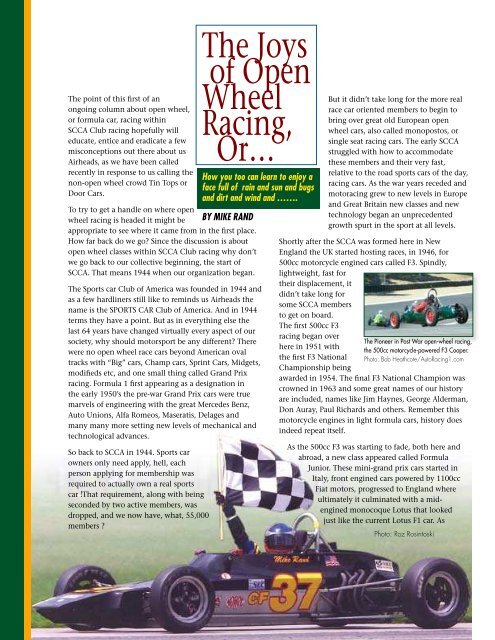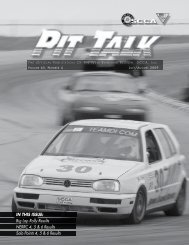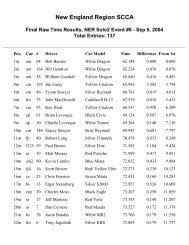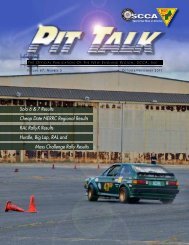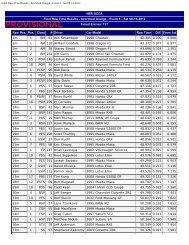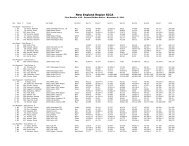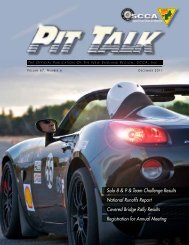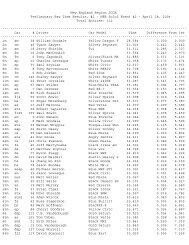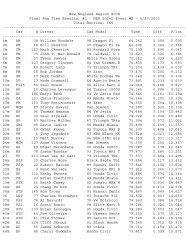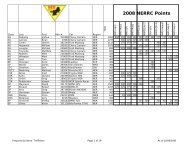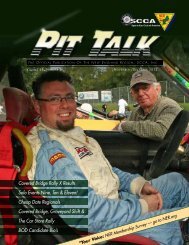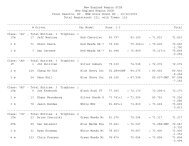NEW ENGLAND REGION OF THE SPORTS CAR CLUB OF AMERICA
NEW ENGLAND REGION OF THE SPORTS CAR CLUB OF AMERICA
NEW ENGLAND REGION OF THE SPORTS CAR CLUB OF AMERICA
Create successful ePaper yourself
Turn your PDF publications into a flip-book with our unique Google optimized e-Paper software.
The point of this first of anongoing column about open wheel,or formula car, racing withinSCCA Club racing hopefully willeducate, entice and eradicate a fewmisconceptions out there about usAirheads, as we have been calledrecently in response to us calling thenon-open wheel crowd Tin Tops orDoor Cars.The Joysof OpenWheelRacing,Or…How you too can learn to enjoy aface full of rain and sun and bugsand dirt and wind and …….To try to get a handle on where openwheel racing is headed it might be BY MIKE RANDappropriate to see where it came from in the first place.How far back do we go? Since the discussion is aboutopen wheel classes within SCCA Club racing why don’twe go back to our collective beginning, the start ofSCCA. That means 1944 when our organization began.The Sports car Club of America was founded in 1944 andas a few hardliners still like to reminds us Airheads thename is the <strong>SPORTS</strong> <strong>CAR</strong> Club of America. And in 1944terms they have a point. But as in everything else thelast 64 years have changed virtually every aspect of oursociety, why should motorsport be any different? Therewere no open wheel race cars beyond American ovaltracks with “Big” cars, Champ cars, Sprint Cars, Midgets,modifieds etc, and one small thing called Grand Prixracing. Formula 1 first appearing as a designation inthe early 1950’s the pre-war Grand Prix cars were truemarvels of engineering with the great Mercedes Benz,Auto Unions, Alfa Romeos, Maseratis, Delages andmany many more setting new levels of mechanical andtechnological advances.So back to SCCA in 1944. Sports carowners only need apply, hell, eachperson applying for membership wasrequired to actually own a real sportscar !That requirement, along with beingseconded by two active members, wasdropped, and we now have, what, 55,000members ?But it didn’t take long for the more realrace car oriented members to begin tobring over great old European openwheel cars, also called monopostos, orsingle seat racing cars. The early SCCAstruggled with how to accommodatethese members and their very fast,relative to the road sports cars of the day,racing cars. As the war years receded andmotoracing grew to new levels in Europeand Great Britain new classes and newtechnology began an unprecedentedgrowth spurt in the sport at all levels.Shortly after the SCCA was formed here in NewEngland the UK started hosting races, in 1946, for500cc motorcycle engined cars called F3. Spindly,lightweight, fast fortheir displacement, itdidn’t take long forsome SCCA membersto get on board.The first 500cc F3racing began overhere in 1951 withthe first F3 NationalChampionship beingThe Pioneer in Post War open-wheel racing,the 500cc motorcycle-powered F3 Cooper.Photo: Bob Heathcote/AutoRacing1.comawarded in 1954. The final F3 National Champion wascrowned in 1963 and some great names of our historyare included, names like Jim Haynes, George Alderman,Don Auray, Paul Richards and others. Remember thismotorcycle engines in light formula cars, history doesindeed repeat itself.As the 500cc F3 was starting to fade, both here andabroad, a new class appeared called FormulaJunior. These mini-grand prix cars started inPhotos by: Kyle TarryItaly, front engined cars powered by 1100ccFiat motors, progressed to England whereultimately it culminated with a midenginedmonocoque Lotus that lookedjust like the current Lotus F1 car. AsPhoto: Roz Rosintoskimanufacturers got involved andthe class grew there were motorsfrom BMC and Ford as well as Fiatand Lancia, Panhard, DB, evenDKW with chassis made virtuallyeverywhere, including the USA.The class became, first, a chassisof the month class, then a motorof the week class, and spiralingcosts led to diminished fields. ThePowers-That-Be in Europe andthe UK figured out somethinghad to change and came upwith a really logical F3-F2-F1scenario. The logic came fromthe class specifications. F3 wasa restricted 1,000cc productionbased motor, F2 was 1,000cc pureracing engines, F1 was 1,500cc.F3 progressed from the 1 literrestricted motor to a 1,600ccrestricted motor ultimately toa 2 liter restricted motor whereit remains to this day. F2 wentfrom 1 liter pure racing engineto 1,600cc pure racing engineto 2 liters finally before beingpensioned off when F3000 camealong after many years of greatcompetition. F1 went from thejewel like 1.5 liter cars to 3 liters,then through the1.5 turbo erato 3.5 liter normally aspiratedto 3 liter to the current 2.4 literspecification.At the same time the SCCAwas going down a similar butdefinitely different path.Thus Ends Part 1Next time we’ll look at the“modern” era, or at least not the1940’s and ‘50’s, and investigatethings like Formula Vee, FormulaFord and the A-B-C’s as well asthe E-M-500’s of SCCA openwheel competition.VIEW FROM <strong>THE</strong> GRIDBy Karen PetersenAt last year’s annual meeting I received a plaque, one of thosethanks for hanging around and paying dues so long things. Abunch of us reminisced about the olden days of SCCA later in theday (when you’re old enough to hang around so long, you tendto do that; wine facilitates this). Pundits still accuse SCCA of beingthe Secret Car Club of America. We can be our own worst enemywhen it comes to self-promotion. Sometimes we in the trenches arejust too busy doing the job to stop and snag passers by.Karen Petersen, stillmad about racing..after 25 years .Photo. R. BeaulieuHowever, in the years gone by things were so different, and noone really objected. When I started (and yes, we had fire and rudimentary tools bythen) you didn’t have to be a member to be in a hot area. You showed up, pastedon an alert expression, and found yourself on the grid or flag station or pits. Youwere suddenly one of the Elite, a race worker, someone allowed to work (rather thanbegged to, as can be the case nowadays). You belonged. You were an insider.I had no idea who was putting on this panorama of cars and people. I just showedup and pasted on said expression. Gradually I learned about sanctioning bodies,and heard the name SCCA. So? The people and the cars were there, and that wasenough for me. The only reason I joined was to begin receiving Pit Talk (always asuperior publication) and to begin to upgrade my grid license status. NER has alwayshad high standards, and receiving a national license was the epitome. It says you areamong the best, taught by the best, and are becoming the best.That first year, like so many of us, I was hooked from the first moment in a paddock.I wanted more! As this was pre-computer days. I found it very hard to know whenraces were scheduled. I asked around, and kind people would grab a snippet ofpaper and write down a couple of dates. I would show up, hoping I would beconsidered good enough to be let in and allowed on the grid. (I’m not joking). Bypestering people I was able to cobble together a full season. That first year I workednon-club events, such as Skip Barber schools (an education in itself). I did anything Icould get my hands on.When I joined, I started getting a wealth of information through Pit Talk, primarily andstarted seeing the structure of SCCA, how a race started as an idea and ended upwith 175 cars on the track. I learned about specialties and trophies and beer parties.I started going to competition board meetings. (You should come; they’re open toeveryone.) I learned even more, from sanction numbers to insurance (by then it hadreared its ugly head) to break-even points. I find it all fascinating. It’s a rather delicatebalancing act to pull it al together. (And that’s another column).So here I am, 25 years later, knowing way more than I ever thought I would. I amone of the venerable (good lord); people ask me for information, and it pops up frommy subconscious. I know something about rallying, lunch breaks, novice permits,pylons, the board of directors, feeling sick inside a helmet...the list is endless.To those not as venerable (and that’s just about all of you, huh? I have one word ofadvice: ask. Ask anyone. We don’t know it all, but can usually find an answer foryou. I remember the impenetrable maze that SCCA was to me, the newbie. We whohave been around have answers, we love our club, and we want to help. Ask!14 PIT TALK PIT TALK February/March 2008 15


